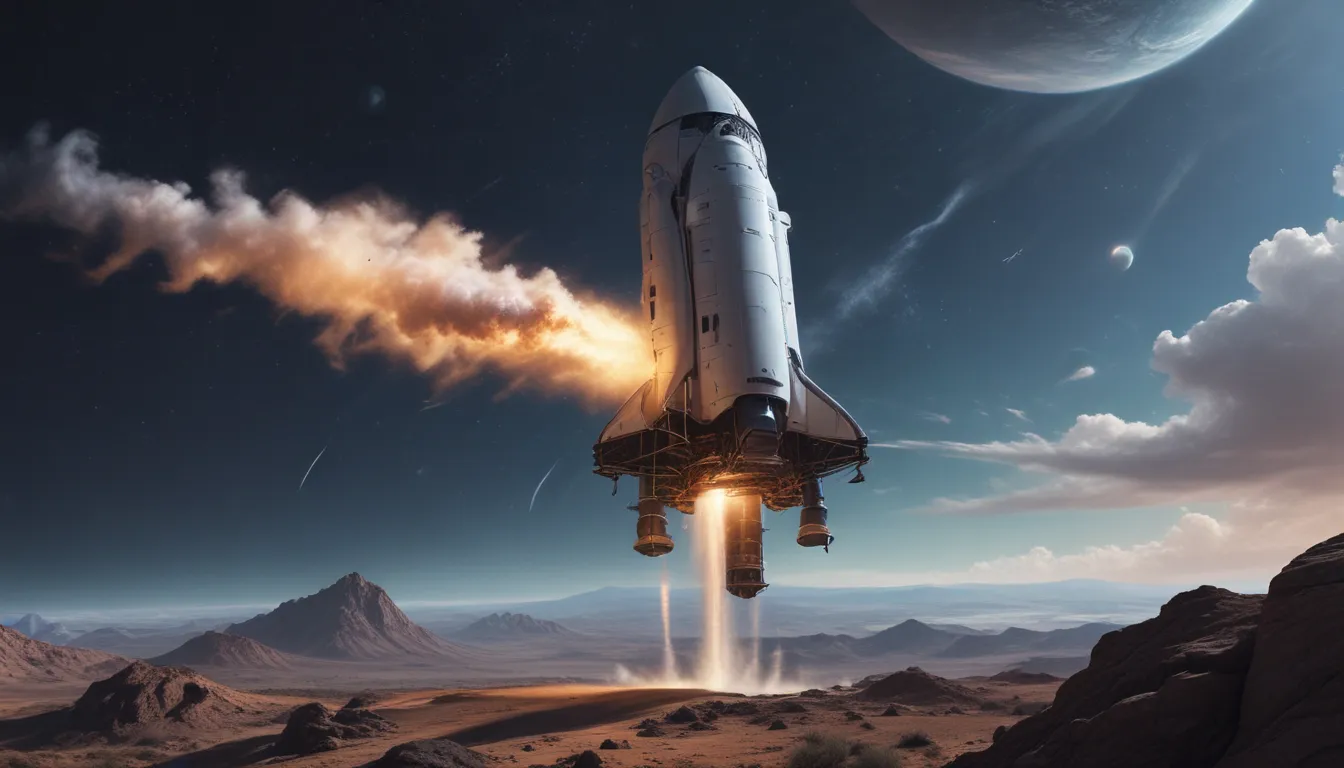The pictures we use in our articles might not show exactly what the words say. We choose these pictures to make you interested in reading more. The pictures work together with the words but don’t take their place. The words still tell you the important facts.
Space exploration has captured the imagination of people worldwide, sparking fascination with the mysteries of the universe. From the historic moon landing to the groundbreaking innovations of companies like Space Exploration Technologies Corp. (SpaceX), the quest for knowledge beyond Earth's atmosphere has never been more exciting. Led by visionary entrepreneur Elon Musk, SpaceX has redefined space travel with its revolutionary technologies and bold ventures.
Key Takeaways:
- SpaceX's pioneering achievements, such as reusable rockets and plans for Mars colonization, are reshaping space exploration and inspiring a new generation of enthusiasts.
- With its innovative technologies and visionary leadership, SpaceX continues to push the boundaries of what is possible in the universe, promising a bright future for space exploration.
Unveiling SpaceX’s Remarkable Achievements
Space Exploration Technologies, or SpaceX, marked a historic milestone with its first successful launch on September 28, 2008. The Falcon 1 rocket, developed by SpaceX, soared into orbit, becoming the first privately developed liquid-fueled rocket to achieve this feat. This momentous event signaled a new era in space exploration.
Revolutionizing Space Travel with Reusable Rockets
One of SpaceX's most impressive advancements is the development of reusable rockets. By successfully landing and reusing rockets, SpaceX has significantly reduced the cost of space missions. This groundbreaking innovation has opened up new possibilities for more frequent and affordable space exploration, paving the way for future exploration endeavors.
Journey to the Stars: The Starship Project
SpaceX's ambitious Starship project aims to create a fully reusable spacecraft capable of carrying humans and cargo to destinations like the Moon and Mars. This revolutionary spacecraft has the potential to transform space travel, enabling long-duration missions to other planets within our solar system. The Starship project represents a giant leap forward in the quest for interplanetary exploration.
Driving Innovation with the Dragon Capsule
The Dragon capsule, another remarkable creation by SpaceX, is designed to transport cargo and crew to the International Space Station (ISS). In 2012, the Dragon capsule made history by becoming the first commercially built and operated spacecraft to dock with the ISS, showcasing SpaceX's capabilities in the realm of space transportation.
Bridging the Digital Divide: Global Internet Coverage
SpaceX envisions providing global broadband internet coverage through its Starlink satellite constellation. By deploying thousands of small satellites in low Earth orbit, SpaceX aims to create a network that can deliver high-speed internet access to even the most remote regions of the world. This ambitious project has the potential to revolutionize connectivity on a global scale.
Partnering with NASA for a Brighter Future
Through strategic collaborations with NASA, SpaceX has secured multiple contracts, including partnerships to transport astronauts to and from the ISS. These collaborations have reshaped the landscape of space exploration, fostering a robust public-private partnership that is driving human spaceflight missions to new heights.
Breaking Barriers with the Starlink Satellite Constellation
The Starlink satellite constellation, developed by SpaceX, is poised to become the largest satellite network ever assembled. With plans to launch tens of thousands of satellites, Starlink has the potential to revolutionize communication not only on Earth but also in space, opening up new possibilities for connectivity beyond our planet.
Setting Records in Space Exploration
In January 2021, SpaceX achieved a remarkable feat by setting a world record for launching the most satellites on a single rocket. The Falcon 9 rocket carried a payload of 143 satellites, including CubeSats and larger satellites, showcasing SpaceX's expertise in handling complex and multi-purpose missions. This achievement reaffirmed SpaceX's position as a leader in the space industry.
Elon Musk’s Martian Dream
SpaceX founder Elon Musk has long envisioned a future where humanity establishes a human settlement on Mars. With the development of the Starship spacecraft, SpaceX is actively working towards enabling crewed missions to the Red Planet, laying the foundation for interplanetary colonization. Musk's vision underscores SpaceX's commitment to pushing the boundaries of space exploration and making ambitious dreams a reality.
Embarking on Unprecedented Lunar Missions
In a groundbreaking announcement in 2018, SpaceX revealed plans to send Japanese billionaire Yusaku Maezawa and a group of artists on a private lunar mission. This project represents the first private mission to orbit the Moon, showcasing SpaceX's bold approach to expanding the frontiers of space exploration and inspiring global curiosity.
Advancing Mars Exploration with Cargo Missions
SpaceX's ambitious agenda includes launching unmanned cargo missions to Mars as early as 2024. These missions will serve as precursors to future crewed expeditions, laying the groundwork for sustaining human presence on the Red Planet. By venturing into uncharted territory, SpaceX aims to unlock the mysteries of Mars and drive scientific progress in planetary exploration.
Perfecting Interplanetary Travel: Test Flights of Starship Prototypes
SpaceX has been conducting rigorous test flights of its Starship prototypes to refine the technology for interplanetary travel. These high-altitude tests have provided invaluable data and insights, contributing to the ongoing enhancements of the spacecraft's design and capabilities. Through relentless innovation and experimentation, SpaceX is forging a path towards safe and efficient interplanetary journeys.
Fueling Discoveries in Space Science
SpaceX's contributions to space science are exemplified by its involvement in missions like the NASA Transiting Exoplanet Survey Satellite (TESS) and the NASA Double Asteroid Redirection Test (DART). These missions aim to expand our understanding of exoplanets and enhance planetary defense capabilities, showcasing SpaceX's dedication to advancing scientific knowledge in space exploration.
Embracing Reusability with the Crew Dragon
In a historic moment in November 2020, SpaceX achieved a significant milestone by launching the first reused Crew Dragon spacecraft with astronauts on board. This achievement underscored SpaceX's commitment to reusability, further reducing the costs associated with human spaceflight and setting new standards for efficiency and sustainability in space travel.
Reviving American Human Spaceflight: The Commercial Crew Program
SpaceX's involvement in NASA's Commercial Crew Program has played a pivotal role in restoring human spaceflight capabilities to US soil. By successfully launching and returning astronauts from American territory using a commercial spacecraft, SpaceX has ushered in a new era of space exploration and cooperation, marking a momentous chapter in the history of space travel.
Unlocking New Horizons with Starship’s Cargo Capacity
Once fully operational, the Starship spacecraft will boast an unprecedented cargo capacity, enabling the transport of large payloads and equipment to destinations across the solar system. This remarkable capability opens up opportunities for ambitious scientific missions and resource utilization on other planets, paving the way for groundbreaking discoveries and advancements in space exploration.
Inspiring the Next Generation of Space Explorers
SpaceX's trailblazing achievements and forward-thinking vision have ignited a spark of inspiration in a new generation of space enthusiasts. By revitalizing public interest in space exploration and innovation, SpaceX is shaping the future of human exploration beyond Earth, fostering a spirit of curiosity and discovery that will propel us towards new frontiers.
In conclusion, the 17 Surprising Facts About Space Exploration Technologies showcase the remarkable advancements and bold aspirations of SpaceX in the realm of space exploration. From reusable rockets to global internet initiatives and Mars exploration plans, SpaceX is revolutionizing the field of space travel with its innovative technologies and visionary leadership. As we look to the stars with wonder and anticipation, SpaceX stands at the forefront of shaping the future of space exploration, pushing the boundaries of possibility and inspiring generations to dream big.
Conclusion
Space exploration technologies have ushered in a new era of discovery and innovation, opening doors to unprecedented opportunities for human exploration beyond Earth's bounds. With advancements like reusable rockets and groundbreaking satellite systems, space exploration technologies have made the cosmos more accessible and affordable, paving the way for groundbreaking missions and scientific breakthroughs. As we embark on this cosmic journey of exploration and discovery, let us celebrate the trailblazers and visionaries who are shaping the future of space exploration, inspiring us to reach for the stars and beyond.
FAQs
- What are some notable space exploration technologies?
Notable space exploration technologies include reusable rockets like SpaceX's Falcon 9 and innovative satellite systems like Starlink.
- How have space exploration technologies made space more accessible?
Space exploration technologies, such as reusable rockets, have significantly reduced the cost of launching payloads into space, making it more accessible for scientific research and commercial endeavors.
- What role do propulsion systems play in space exploration technologies?
Propulsion systems are essential for space exploration technologies as they provide the necessary thrust to launch spacecraft into space and maneuver them in orbit.
- How have robotics advancements contributed to space exploration technologies?
Robotics advancements, such as the use of rovers and robotic arms, have enabled scientists to collect data and conduct experiments in environments that are inhospitable to humans, such as Mars.
- What is the significance of communication systems in space exploration?
Communication systems play a vital role in space exploration technologies, facilitating real-time transmission of data between spacecraft and Earth, essential for mission control and scientific research.
Space exploration technologies continue to captivate imaginations, pushing boundaries of what's possible. Elon Musk's SpaceX leads charge, revolutionizing the industry with reusable rockets, ambitious Mars plans, and record-breaking satellite launches. As we ponder the future of space travel, let's also reflect on visionaries behind these advancements. Explore surprising facts about Peter Diamandis, a renowned entrepreneur, futurist driving innovation. Diamandis's contributions span multiple industries, from space exploration to longevity research, uncovering astounding details about his life, work, and insights into the mind of a true pioneer shaping our world.
Our commitment to delivering trustworthy and engaging content is at the heart of what we do. Each fact on our site is contributed by real users like you, bringing a wealth of diverse insights and information. To ensure the highest standards of accuracy and reliability, our dedicated editors meticulously review each submission. This process guarantees that the facts we share are not only fascinating but also credible. Trust in our commitment to quality and authenticity as you explore and learn with us.






